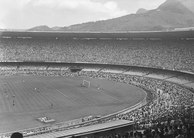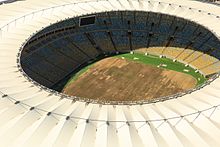History
Construction
After winning the right to host the 1950 FIFA World Cup, the Brazilian government sought to build a new stadium for the tournament. The construction of Maracanã was criticized by Carlos Lacerda, then Congressman and political enemy of the mayor of the city, general Ângelo Mendes de Morais, for the expense and for the chosen location of the stadium, arguing that it should be built in the West Zone neighborhood of Jacarepaguá. At the time, a tennis stadium stood in the chosen area. Still it was supported by journalist Mário Filho, and Mendes de Morais was able to move the project forward. The competition for the design and construction was opened by the municipality of Rio de Janeiro in 1947, with the construction contract awarded to engineer Humberto Menescal, and the architectural contract awarded to seven Brazilian architects, Michael Feldman, Waldir Ramos, Raphael Galvão, Oscar Valdetaro, Orlando Azevedo, Pedro Paulo Bernardes Bastos, and Antônio Dias Carneiro.[5]The first cornerstone was laid at the site of the stadium on 2 August 1948.[6] With the first World Cup game scheduled to be played on 24 June 1950, this left a little under two years to finish construction. However, work quickly fell behind schedule, prompting FIFA to send Dr. Ottorino Barassi, the head of the Italian FA, who had organized the 1934 World Cup, to help in Rio de Janeiro. A work force of 1,500 constructed the stadium, with an additional 2,000 working in the final months. Despite the stadium having come into use in 1950, the construction was only fully completed in 1965.
Opening and 1950 FIFA World Cup
Opening game of the Maracanã Stadium, shortly before the 1950 FIFA World Cup.
Postage stamp featuring the Maracanã, commemorating the 1950 FIFA World Cup.
In that first match for which Maracanã had been built, Brazil beat Mexico with a final score 4–0, with Ademir becoming the first scorer of a competitive goal at the stadium with his 30th-minute strike. Ademir had two goals in total, plus one each from Baltasar and Jair. The match was refereed by Englishman George Reader. Five of Brazil's six games at the tournament were played at Maracanã (the exception being their 2–2 draw with Switzerland in São Paulo). Eventually, Brazil progressed to the final round, facing Uruguay in the match (part of a round-robin final phase) that turned out to be the tournament-deciding match on 16 July 1950. Brazil only needed a draw to finish as champion, but Uruguay won the game 2–1, shocking and silencing the massive crowd. This defeat on home soil instantly became a significant event in Brazilian history, being known popularly as the Maracanazo. The official attendance of the final game was 199,854, with the actual attendance estimated to be about 210,000.[8][9] In any case, it was the largest crowd ever to see a football game—a record that is highly unlikely to be threatened in an era when most international matches are played in all-seater stadiums. At the time of the World Cup, the stadium was mostly grandstands with no individual seats.
Stadium completion and post-World Cup years
In 1989 the stadium hosted the games of the final round of the Copa America; in the same year, Zico scored his final goal for Flamengo at the Maracanã, taking his goal tally at the stadium to 333, a record that still stood as of 2011. An upper stand in the stadium collapsed on 19 July 1992, in the second game of the finals of 1992 Campeonato Brasileiro Série A, between Botafogo and Flamengo, leading to the death of three spectators and injuring 50 others.[11] Following the disaster, the stadium's capacity was greatly reduced as it was converted to an all-seater stadium in the late 1990s. Despite this, the ground was classified as a national landmark in 1998, meaning that it could not be demolished.[citation needed] The stadium hosted the first ever FIFA Club World Cup final match between CR Vasco da Gama and Corinthians Paulista, which Corinthians won on penalties.
21st century, renovations and 2014 FIFA World Cup
Panorama from inside the stadium during the closing ceremony of the 2014 FIFA World Cup
For the 2014 World Cup and 2016 Olympics and Paralympics, a major reconstruction project was initiated in 2010. The original seating bowl, with a two-tier configuration, was demolished, giving way to a new one-tier seating bowl.[12] The original stadium's roof in concrete was removed and replaced with a fiberglass tensioned membrane coated with polytetra-fluoroethylene. The new roof covers 95% of the seats inside the stadium, unlike the former design, where protection was only afforded to some seats in the upper ring and the bleachers above the gate access of each sector. The old boxes, which were installed at a level above the stands for the 2000 FIFA Club World Championship, were dismantled in the reconstruction process. The new seats are colored yellow, blue and white, which combined with the green of the match field, form the Brazilian national colors. In addition, the grayish tone has returned as the main façade color of the stadium.
On 30 May 2013, a friendly game between Brazil and England scheduled for 2 June was called off by a local judge because of safety concerns related to the stadium. The government of Rio de Janeiro appealed the decision[13] and the game went ahead as originally planned, the final score being a 2–2 draw.[13][14] This match marked the reopening of the new Maracanã.[12]
On 12 June 2014, the 2014 FIFA World Cup opened with Brazil defeating Croatia 3–1, but that match was held in São Paulo. The first game of the World Cup to be held in Maracanã was a 2–1 victory by Argentina over Bosnia-Herzegovina on Sunday, 15 June 2014. Host Brazil ended up never playing a match in the Maracanã during the tournament, as they failed to reach the final after being eliminated in the semi-finals 7-1 by Germany. In the final, Germany defeated Argentina 1–0 in extra time.[15]
Disrepair after the 2016 Summer Olympics
Aerial photograph of Maracanã's playing field in February 2017
Within six months of the games, daily tours of the stadium were halted due to vandalism at the stadium and violent robberies in the area. Items of value have been looted from the stadium including fire extinguishers, televisions and a bronze bust of journalist Mário Filho, for whom the stadium was named.[17][18]






No comments:
Post a Comment